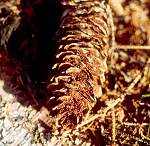Spruce cone grate
| Spruce cone grate | ||||||||||||
|---|---|---|---|---|---|---|---|---|---|---|---|---|

Spruce cone rust ( Pucciniastrum areolatum ) |
||||||||||||
| Systematics | ||||||||||||
|
||||||||||||
| Scientific name | ||||||||||||
| Pucciniastrum areolatum | ||||||||||||
| ( Fr. ) GH Otth |
The spruce cone rust or cone rust of the spruce ( Pucciniastrum areolatum , syn .: Thekopsora areolata ) is a rust fungus that attacks the spruce cones. The name cone rust is sometimes used for another rust fungus, namely the yellow cone rust ( Chrysomyxa pyrolae ).
Features and ecology
The cone grate grows through the red spruce cones , which get bulky scales from the fungus. Acidiospores are then formed on the top of the scales by summer . These are thick-walled and measure 25 × 18 μ. As with many rust fungi, there is an obligatory change of host to common bird cherry ( Prunus padus ) or late blooming bird cherry ( Prunus serotina ). The formation of the Urdedolager causes them to develop dark red spots on both sides of the leaves in summer.
The fungus has also been detected on annual shoots of young spruce, where they cause a blackish discoloration of the bark surface and the death of the shoot.
activities
Due to the obligatory change of host, the disease is avoided by removing the intermediate host (common bird cherry) in a radius of approx. 500 m. However, the pathogen is only of economic importance in seed orchards.
Individual evidence
- ↑ Th. L. Cech, B. Perny, E. Donaubauer: Treetop dieback on young spruces in Austria and involved micro-fungi . FBVA reports, 1995.
literature
- Heinz Butin : Diseases of the forest and park trees . Georg Thieme Verlag, 1983, ISBN 3-13-639002-4 .
Web links
- TL Cech: Phytopathological Notes 2008 (PDF; 291 kB)
- Photos on ipmimages